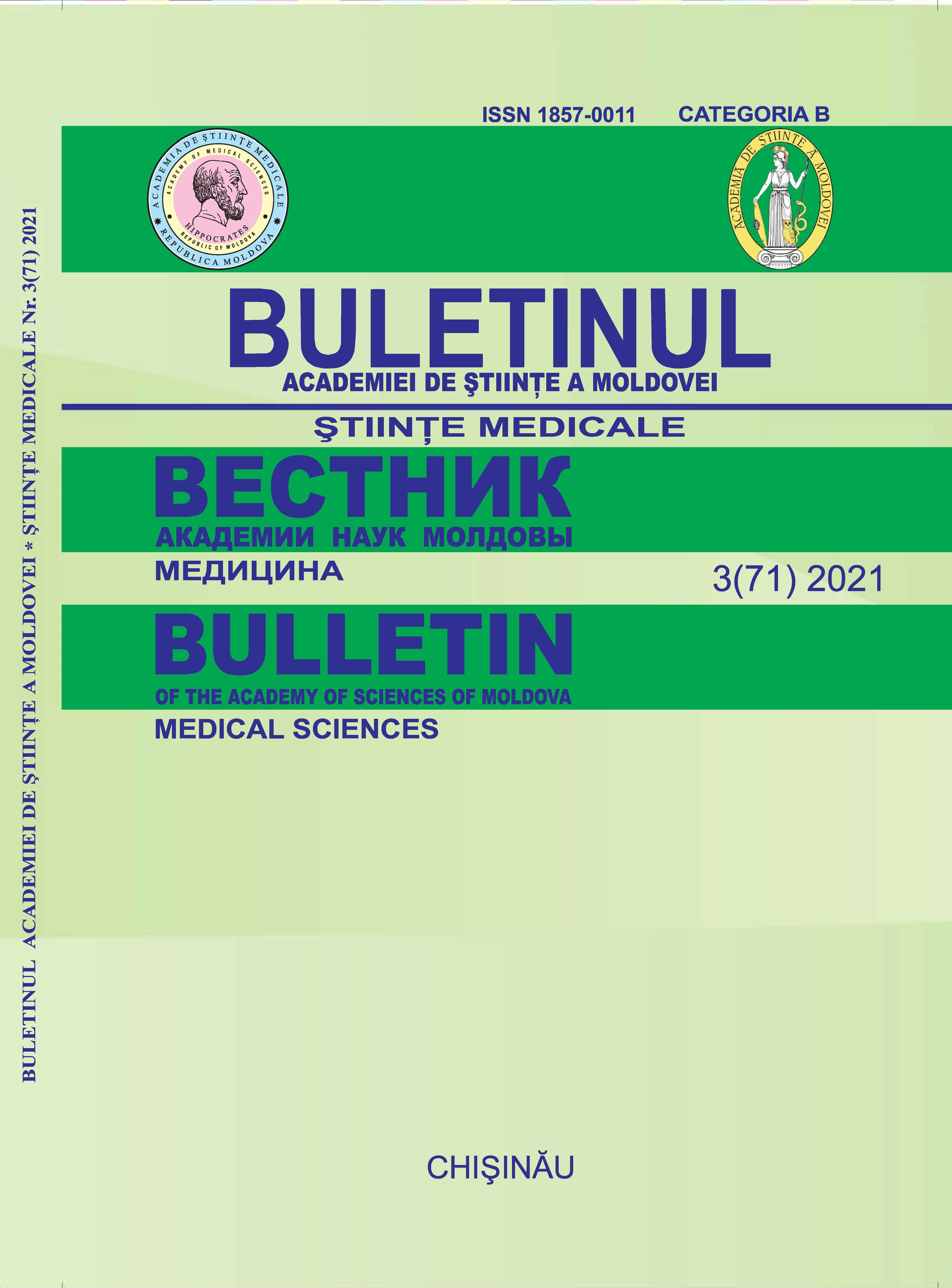General notions of epidemiology, etiopathogenesis and treatment in recurrent laryngeal papillomatosis (literature review).
DOI:
https://doi.org/10.52692/1857-0011.2021.3-71.36Keywords:
recurrent laryngeal papillomatosis, HPV, treatmentAbstract
Recurrent laryngeal papillomatosis is a benign tumor of the respiratory tract caused by HPV type 6 or 1 infection. It is considered a manageable rather than curable disease due to its high recurrence rates and unpredictable clinical course.The unique molecular characteristics of the virus induce cell proliferation causing airway obstruction. The main symptoms are hoarseness, inspiratory and expiratory screaming, dysphagia. The mechanisms responsible for the variability of clinical course and the persistence of latent HPV infection remain unknown. It is believed that both the adaptive and the innate immune response given by patients with papillomatosis support chronic infection. Patients with laryngeal papillomas are not able to produce an effective HPV-specific T cell response, as shown by an altered CD8 + subgroup and Th1 / Th2 cytokine imbalance with suppression of the Th1 response. There is a genetic association between certain severely disease-type HLA genes and down-regulation of type I HLA genes. Surgical excision, including new methods such as microdebrider and CO2 laser surgery, aims to provide a respiratory tract. and improve the voice, but can also cause serious complications such as airway stenosis. Recent advances in immune system research may provide an improvement in our treatment modalities and prevention strategies in this pathology.References
Cabac V., Scutelnic L. Papilomatoza laringelui la copil: aspecte clinic-epidemiologice. Sănătate Publică, Economie și Management în medicină, Chișinău 2016
Cabac V. Papilomatoza recidivantă a laringelui la copil, aspecte epidemiologice (Revista literaturii). Buletinul Academiei de Științe a Moldovei. Științe Medicale 40 (4), 194-197
Cernev D., PhD and Cabac V., Md. PhD. Recurrent Papillomatosis of the Larynx. Etiological Aspects,Risk Factors and the Prognosis of Clinical Evolution: A Review of Literature. Merit Research Journal of Medicine and Medical Sciences (ISSN: 2354-323X) Vol. 8(10) pp. 584-588, October, 2020
Derkay CS, Wiatrak B. Recurrent Respiratory Papilloma tosis: A Review. Laryngoscope 2008; 118: 1236-47. [CrossRef] [PubMed] 2. Katsenos S, Becker HD. Recurrent Respiratory Papillomatosis: A Rare Chronic Disease,Difficult to Treat, with Potential to Lung Cancer Trans formation: Apropos of Two Cases and a Brief Literature Review. Case Rep Oncol 2011;4:162-71.
Maiga S., Ndiaye C., Diouf M., et al. Laryngeal papillomatosis in Senegal: a ten years experience. European Annals of Otorhinolaryngology, Head and Neck Diseases. 2017;135:221–224.
Reeves WC, Ruparelia SS, Swanson KI, Derkay CS, Marcus A, Unger ER. National Registry for JuvenileOnset Recurrent Respiratory Papillomatosis. Arch Otolaryngol Head Neck Surg 2003; 129:976-82.
Leung R, Hawkes M, Campisi P. Severity of juvenile onset recurrent respiratory papillomatosis is not associated with socioeconomic status in a setting of universal health care. Int J Pediatr Otorhinolaryngol 2007; 71(6):965-72.
Zacharisen MC, Conley SF. Recurrent Respiratory Papillomatosis in Children: Masquerader of Common Respiratory Diseases. Pediatrics 2006; 118:1925.
Barnes L, Eveson JW, Reichart P, Sidransky D. Pathology and Genetics of Head and Neck Tumors. Lyon: IARC Press; 2005.
Larson DA, Derkay CS. Epidemiology of recurrent respiratory papillomatosis. APMIS 2010; 118(6– 7):450-4.
Oh ST, Longworth MS, Laimins LA. Roles of the E6 and E7 proteins in the life cycle of low-risk human papillomavirus type 11.J Virol. 2004;78(5): 2620-2626.
Kocjan BJ, Gale N, Hocevar Boltezar I et al. Identical human papillomavirus (HPV) genomic variants persist in recurrent respiratory papillomatosis for up to 22 years. J Infect Dis 2013; 207:583–7.
Pignatari S, Smith EM, Gray SD, Shive C, Turek LP. Detection of human papillomavirus infection in diseased and nondiseased sites of the respiratory tract in recurrent respiratory papillomatosis patients by DNA hybridization. Ann Otol Rhinol Laryngol 1992; 101:408–12
Welters MJ, de Jong A, van den Eeden SJ, van der Hulst JM, Kwappenberg KM, Hassane S, et al. Frequent display of human papillomavirus type 16 E6-specific memory t-Helper cells in the healthy population as witness of previous viral encounter. Cancer Res 2003; 63:636-41.
Abramson AL, Steinberg BM, Winkler B. Laryngeal papillomatosis: clinical, histopathologic and molecular studies. Laryngoscope 1987; 97:678-85.
Smith EM, Pignatari SS, Gray SD, Haugen TH, Turek LP. Human papillomavirus infection in papillomas and nondiseased respiratory sites of patients with recurrent respiratory papillomatosis using the polymerase chain reaction. Arch Otolaryngol Head Neck Surg 1993;119(5):554-7.
Bonagura VR, Hatam LJ, Rosenthal DW, DeVoti JA, Lam F, Steinberg BM, et al. Recurrent respiratory papillomatosis: A complex defect in immune responsiveness to human papillomavirus-6 and -11. APMIS 2010; 118(6-7):455-70.
Bonagura VR, Hatam L, DeVoti J, Zeng F, Steinberg BM. Recurrent respiratory papillomatosis: altered CD81 T-Cell subsets and TH1/TH2 cytokine imbalance. Clinical Immunology 1990; 93:302-11.
Rosenthal DW, DeVoti JA, Steinberg BM, Abramson AL, Bonagura VR. TH2-like chemokine patterns correlate with disease severity in patients with recurrent respiratory papillomatosis. Mol Med 2012; 18:1338- 45.
Naren N. Venkatesan,Harold S. Pine, and Michael P. Underbrink, Recurrent Respiratory Papillomatosis. Otolaryngol Clin North Am. 2012 Jun; 45(3): 671–ix.
M. Carifi, D. Napolitano, M. Morandi, et al., Recurrent respiratory papillomatosis: current and future perspectives, Ther. Clin. risk Manag. 11 (2015) 731-738.
S. Katsenos, H. Becker, Recurrent respiratory papillomatosis: a rare chronic disease, difficult to treat, with potential to lung cancer transformation: a propos of two cases and a brief literature review, Case Rep. Oncol. 4 (1) (2011) 162-171
A.J. Donne, L. Hampson, J.J. Homer, et al., The role of HPV type in recurrent respiratory papillomatosis, Int. J. Pediatr. Otorhinolaryngol. 74 (1) (2010) 7-14.
Downloads
Published
Issue
Section
License
Copyright (c) 2022 Bulletin of the Academy of Sciences of Moldova. Medical Sciences

This work is licensed under a Creative Commons Attribution 4.0 International License.



